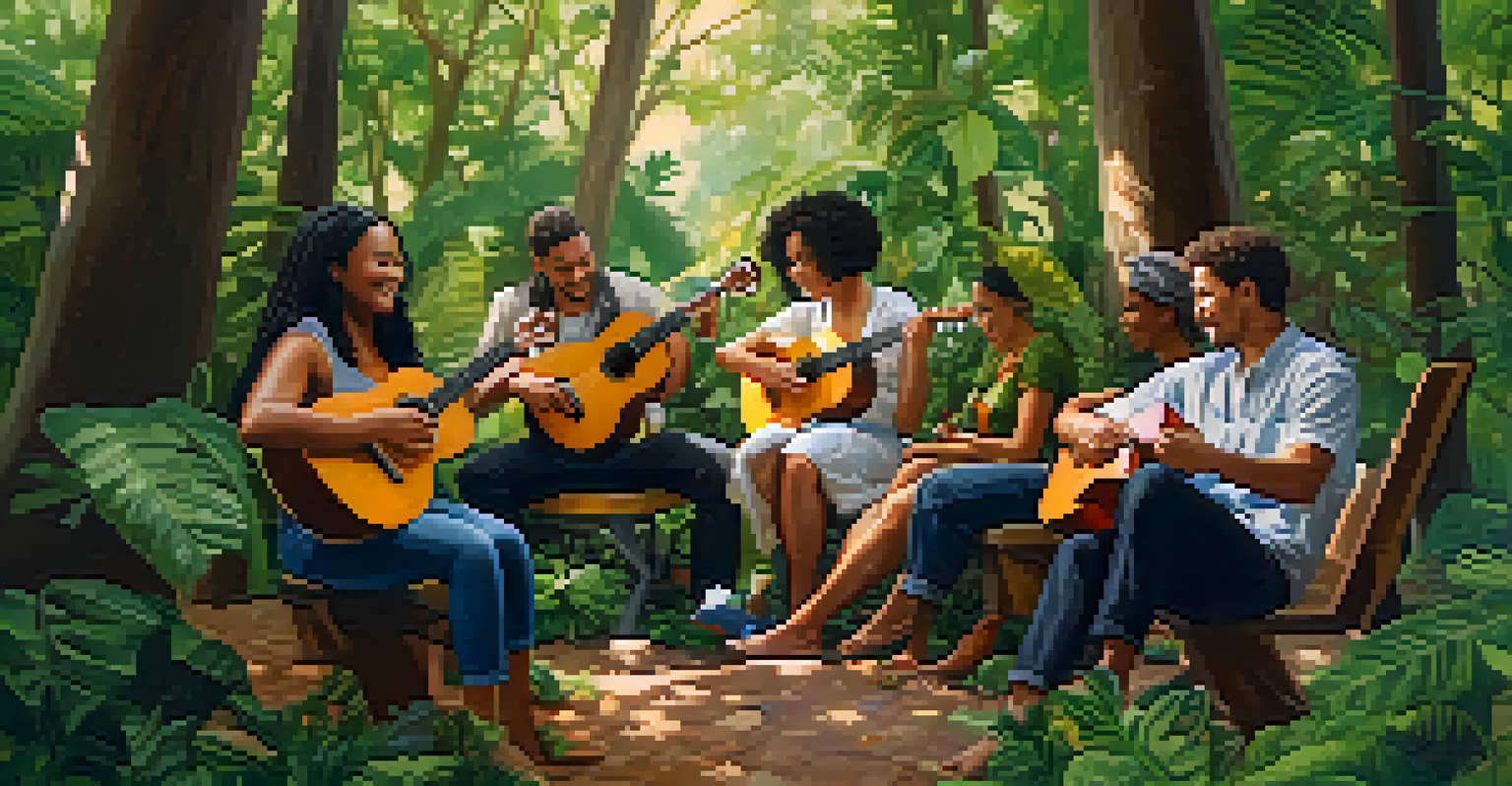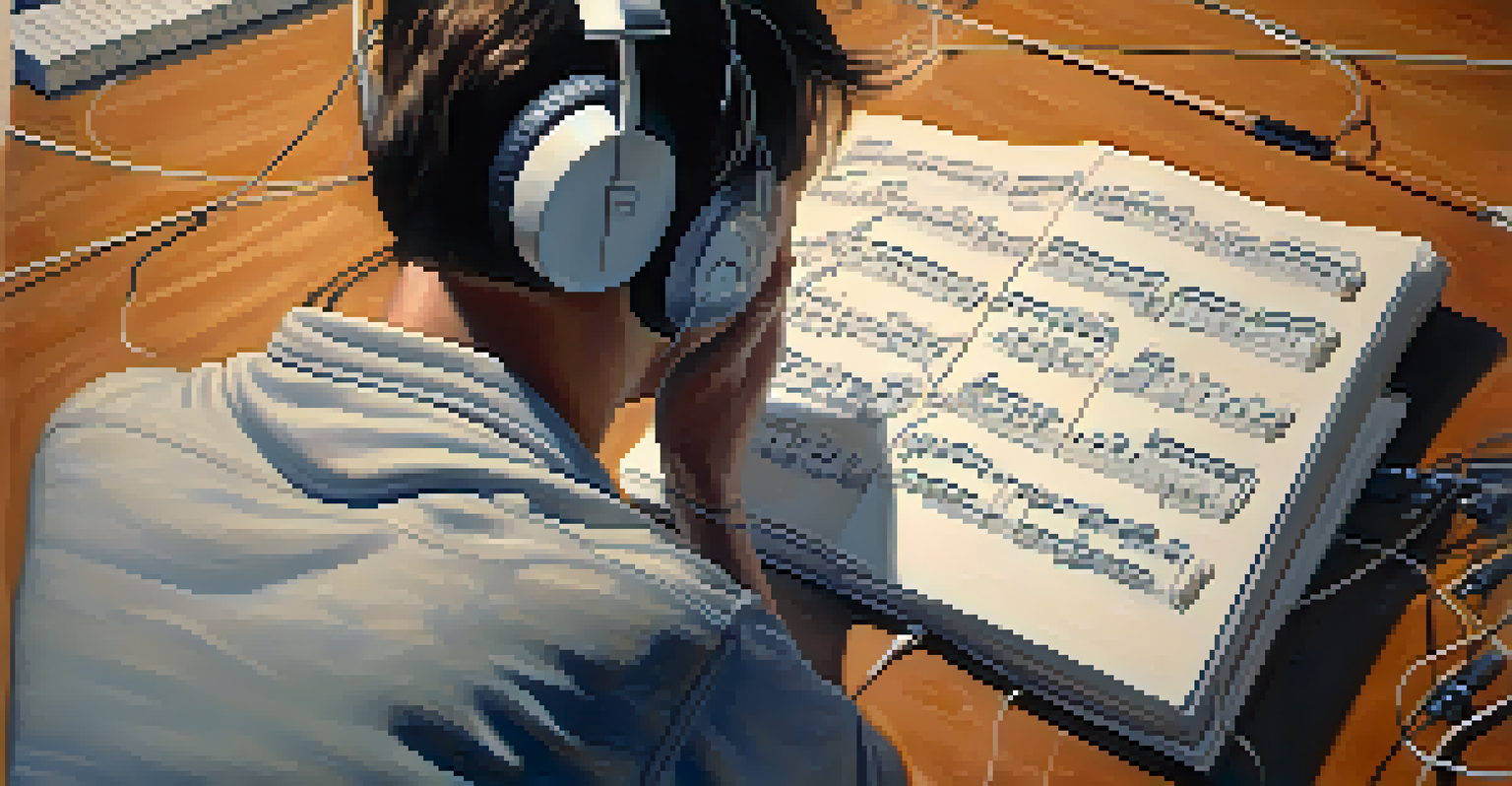Essential Techniques for Learning Ukulele by Ear Effectively

Understanding the Basics of Ear Training
Ear training is the process of developing the ability to identify notes, chords, and rhythms by hearing them. It's a fundamental skill for any musician, especially for ukulele players who want to learn songs without relying on sheet music. By honing your ear, you can pick up melodies and harmonies more intuitively.
To listen is to lean in, softly, with a willingness to be changed by the experience.
Start by familiarizing yourself with the sound of each note on the ukulele. Play each string open and then again at different frets, listening closely to how the pitch changes. This will help you recognize notes when you hear them in songs, making it easier to replicate them on your instrument.
Incorporating simple exercises, like singing back notes you hear or practicing intervals, can significantly enhance your ear training experience. As you progress, you'll find that identifying chords and melodies becomes less of a challenge and more of a pleasure.
Listening Actively: The Key to Learning by Ear
Active listening is essential when learning to play the ukulele by ear. This means paying close attention to the nuances of the music, rather than just hearing it passively. Focus on individual instruments and how they interact, which will help you distinguish different elements within a piece.

To practice active listening, choose a song you love and listen to it multiple times. Each time, focus on a different aspect, such as the rhythm, melody, or harmony. This approach will deepen your understanding of the song's structure and make it easier to reproduce on your ukulele.
Develop Your Ear for Music
Ear training is essential for musicians, allowing them to identify notes, chords, and rhythms intuitively.
Additionally, try to break the song down into smaller sections. Listen to a few bars, pause, and then attempt to play them on your ukulele. This method not only reinforces what you’ve heard but also builds your confidence in playing by ear.
Utilizing Technology for Ear Training
In today's digital age, there are numerous apps and online tools designed to aid in ear training. These resources can make practice more fun and interactive, allowing you to develop your skills at your own pace. Many apps offer exercises that focus on identifying chords, intervals, and even melodies.
Music can change the world because it can change people.
Some popular ear training apps include 'EarMaster' and 'Tenuto.' They provide a range of activities, from recognizing notes to playing back melodies you hear. Using these tools can help reinforce your learning and keep you engaged.
Remember to balance technology with traditional practice methods. While apps are great for training, nothing beats the experience of playing along with recordings or live musicians, which can enhance your learning process even further.
Transcribing Songs: A Practical Approach
Transcribing songs is an excellent way to improve your ear and your playing skills simultaneously. This involves listening to a song and writing down the notes, chords, or lyrics as you hear them. Although it might seem daunting at first, breaking it into manageable parts can make the process easier and more rewarding.
Start with simple songs that you enjoy and can easily follow. Play a few seconds of the song, pause, and try to capture what you heard on your ukulele. Focus on one instrument at a time, and don’t hesitate to replay sections until you feel confident in your transcription.
Practice Active Listening Skills
Focusing on the nuances of music through active listening enhances your ability to learn songs by ear.
As you become more comfortable with transcribing, challenge yourself with more complex pieces. This not only enhances your ear training but also deepens your understanding of musical structure and composition.
Experimenting with Improvisation
Improvisation is a fantastic way to develop your musical ear while having fun with your ukulele. It encourages you to think creatively and explore different sounds and styles. The more you improvise, the more you’ll learn to trust your instincts and play what you hear in your head.
Begin by playing along with a simple backing track or a metronome. Experiment with different notes, scales, and rhythms as you play. Don’t be afraid to make mistakes; they often lead to unexpected discoveries that can enhance your musical vocabulary.
As you gain confidence, try improvising over more complex chord progressions. This not only challenges your ear but also helps you understand how different notes relate to each other within a piece of music.
Playing Along with Your Favorite Songs
One of the best ways to learn the ukulele by ear is to play along with songs you love. This practice makes learning enjoyable and motivates you to keep improving. Start by finding songs that feature simple chords and melodies, and gradually work your way up to more intricate pieces.
When playing along, focus on matching the rhythm and feel of the song. Try to replicate the strumming patterns and nuances of the original artist. This not only sharpens your ear but also enhances your ability to play in time with other musicians.
Engage with Technology and Community
Utilizing apps for ear training alongside participating in a supportive community can significantly improve your musical skills.
As you become more comfortable, challenge yourself to play along with songs that have multiple instruments. This will help you identify how the ukulele fits within a larger musical context and improve your overall musicianship.
Joining a Community for Support and Growth
Joining a community of ukulele players can provide invaluable support and encouragement on your journey to learning by ear. Whether online or in-person, these groups often share tips, resources, and experiences that can enhance your learning process. Plus, being part of a community can keep you motivated and accountable.
Look for local ukulele clubs, online forums, or social media groups where you can connect with fellow players. Sharing your progress, asking questions, and participating in group activities can significantly enrich your learning experience.

Don't hesitate to collaborate with other musicians, even if they play different instruments. Jamming together can expose you to new musical ideas and techniques, ultimately making you a more versatile player.